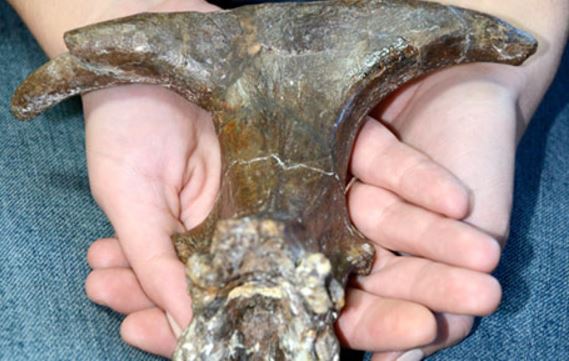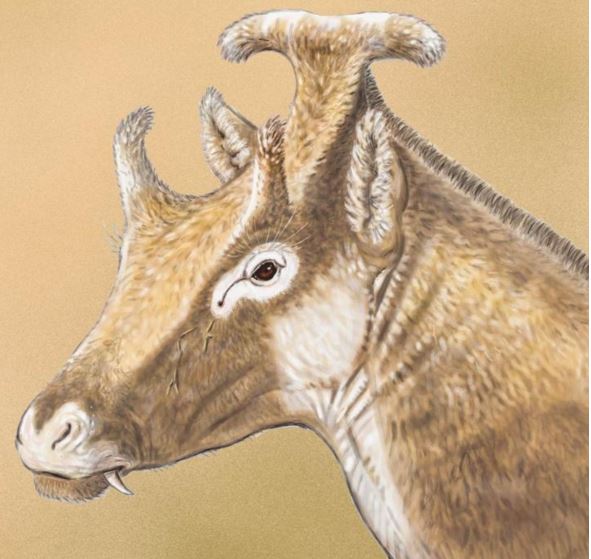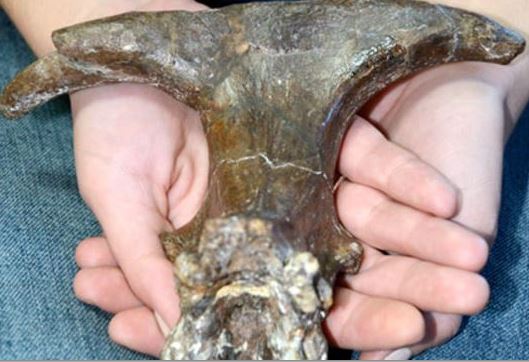A strange three-horned, giraffe-like animal with fangs, that lived in Europe 15 million years ago, has been named Xenokeryx amidalae, after Padmé Amidala who became Queen of Naboo, a Star Wars monarch played by actress Natalie Portman. Xenokeryx amidalae, which means ‘strange horn of Amidala’, was found in the Cuenca province of Spain and shares a common ancestor with modern-day giraffes.
Israel M. Sánchez, from the Museo Nacional de Ciencias Naturales-CSIC (National Museum of Natural History), and colleagues wrote about their finding in the open-access journal PLoS ONE.
The animal was a three-horned palaeomerycid ruminant. These types of animals, now extinct, were weird three-horned Eurasian Miocene ruminants known through fossils unearthed from China to Spain.
 According to the museum “This discovery establishes the shared ancestry of palaeomerycid ruminants and the evolution of the giraffe.” (Image: National Museum of Natural History, Madrid)
According to the museum “This discovery establishes the shared ancestry of palaeomerycid ruminants and the evolution of the giraffe.” (Image: National Museum of Natural History, Madrid)
Xenokeryx amidalae were ruminants
The scientists classify the palaeomerycid to their clade based on shared features with the best-known species of the group. Sánchez and colleagues confirm they were ruminants. Clade is a group of organisms believed to have evolved from a common ancestor.
The skull of this specimen was well preserved – including both frontal and supra-occipital ‘T-shaped’ cranial appendages. It was unearthed among middle Miocene deposits in Spain.
Before this study, some scientists had suggested that Eurasian palaeomerycids were closely-related to North American dromomerycids – distant relatives to deer. The authors of this latest study insist that this is not the case, despite their apparent external similarities.
Instead, palaeomerycids belong to the Giraffomorpha clade, the least inclusive clade containing Triceromeryx and Giraffa.
 This is a reconstruction of X. amidalae. (Image: eurekalert.org. Credit: Israel M. Sánchez)
This is a reconstruction of X. amidalae. (Image: eurekalert.org. Credit: Israel M. Sánchez)
X. amidalae was a herbivorous animal, about the size of a deer. The males had two small horns above the eyes, like today’s giraffes, and a larger T-shaped one on the back of the head.
The males also had large, sabre-like upper canines that were probably used for display to show off to other members of the species, Sánchez believes. The females had neither horns nor fangs.
X. amidalae favoured grasslands with rivers, and probably rubbed shoulders with deer, horses, crocodiles, rhinos, ancestors of elephants, and ‘bear dogs’ (an extinct large predator). Its diet probably consisted of roots, leaves and fruit.
Its closest modern relative is believed to be the giraffe and okapi, even though it did not have a long neck.
 X. amidalae was named after Padmé Amidala, a fictional Star Wars character played by Natalie Coleman.
X. amidalae was named after Padmé Amidala, a fictional Star Wars character played by Natalie Coleman.
Israel Sánchez wrote:
“Establishing the place of palaeomerycids in the ruminant tree gives us insights into the evolutionary history of the large clade of pecoran ruminants that include giraffes (Giraffa and Okapia) as its only extant survivors, and shows us the amazing diversity of an ancient lineage that inhabited both Eurasia and Africa.”
Citation: “Systematics and Evolution of the Miocene Three-Horned Palaeomerycid Ruminants (Mammalia, Cetartiodactyla),” Sánchez IM, Cantalapiedra JL, Ríos M, Quiralte V and Morales J. PLoS ONE 10(12): e0143034. DOI:10.1371/journal.pone.0143034.

